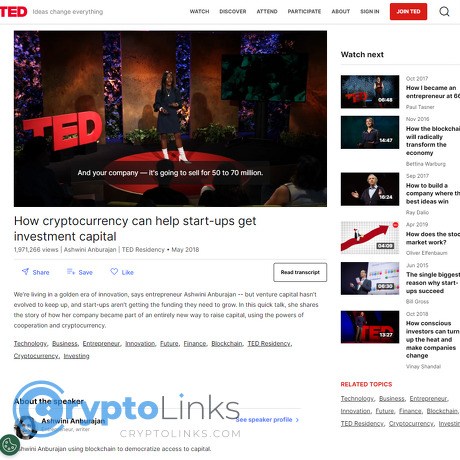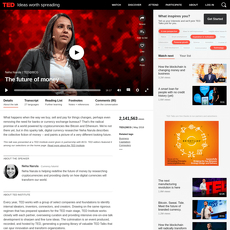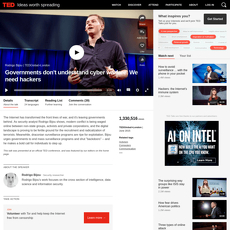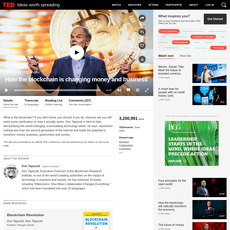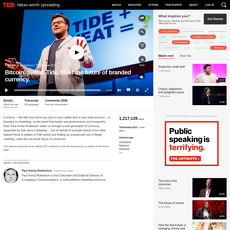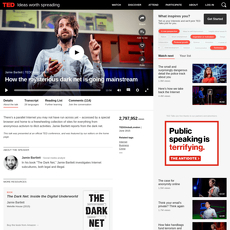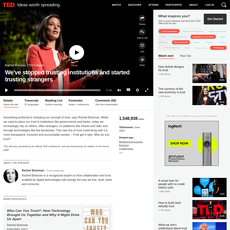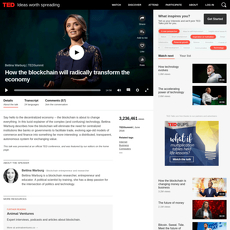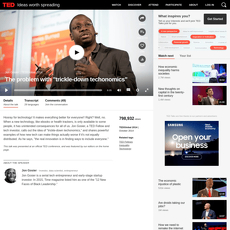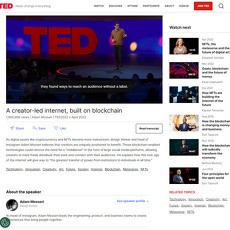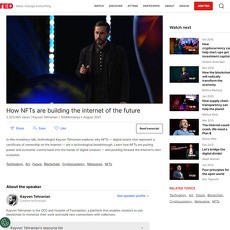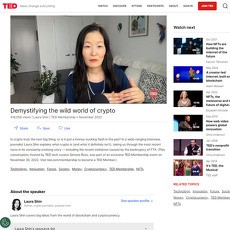Ashwini Anburajan: How cryptocurrency can help start-ups get investment capital Review
Ashwini Anburajan: How cryptocurrency can help start-ups get investment capital
www.ted.com
Ashwini Anburajan: How Cryptocurrency Can Help Startups Get Investment Capital — Review Guide with Real-World Tips and FAQ
What if you could raise your first $250k–$2M without waiting months for warm intros or pitching the same deck 60 times? That’s the core question behind Ashwini Anburajan’s TED Talk, “How cryptocurrency can help start-ups get investment capital.” I’ve watched it multiple times and pulled together a practical guide you can actually use, starting with the problems founders face—and how crypto changes the game. If you want to watch the source first, here’s the talk and transcript: Ashwini Anburajan on TED.
Why traditional fundraising hurts more than it helps (for most early founders)
Let’s be real: the default playbook isn’t built for speed or fairness. If you’re outside the usual networks, the odds get worse. Here’s what I see founders run into again and again:
- Slow, distracting timelines: Typical pre-seed/seed rounds often stretch 3–6 months, even for strong teams. DocSend’s fundraising studies show weeks of pitching, follow-ups, and DD just to get a “maybe.” That’s half a year of momentum tax.
- Gatekeeping and geography bias: Warm intros dominate. If you’re not already connected or near major hubs, doors stay shut, regardless of product potential.
- High legal and setup costs: Even “simple” rounds aren’t free. SAFEs help, but costs add up. Priced rounds can run tens of thousands in legal for both sides. That’s runway you could spend on shipping.
- Tiny local backer pools: Your first 100 true fans might be global. Traditional funding makes it hard for those people to participate in a meaningful, aligned way.
- No easy path for small checks: Early believers—developers, power users, community members—rarely have a compliant, low-friction way to back you with $100–$1,000.
- Liquidity locked for years: Traditional equity can trap value 7–10+ years until an exit. Meanwhile, your early community gets no ongoing alignment signal.
- Community misalignment: Users who evangelize you don’t share upside, and investors who hold your cap table don’t necessarily grow your product’s network effects.
Net effect: you spend months fundraising from a small set of gatekeepers while your most passionate supporters watch from the sidelines.
What crypto makes possible (and why it’s different)
This is where Ashwini’s thesis clicks: crypto can turn your users into backers, your backers into community, and your community into durable momentum. Done right, it looks like this:
- Global access, 24/7 rails: Accept support from anywhere with internet access. Small checks are welcome, not awkward.
- Programmable alignment: Tokens let you reward real contributions—usage, referrals, code, content—with ownership-like incentives that vest and unlock transparently.
- Faster liquidity options: Not a promise of profit, but a practical path: tokens can be designed with clear vesting and controlled liquidity, so value isn’t frozen for a decade.
- Transparent treasuries: On-chain addresses, spend tracking, and milestone-based releases make your runway and priorities visible without smoke and mirrors.
- Community ownership: Early supporters aren’t just cheering; they’re participating. That energy compounds into product-market-community fit.
We’re already seeing hints of this model in the wild:
- Gitcoin Grants: Quadratic funding channels small contributions into big outcomes for open-source work, with matching pools on-chain.
- ENS airdrop and governance: Early users received tokens tied to real utility and voting—aligning long-term stewards with the protocol’s growth.
- Mirror crowdfunds: Creators and teams raise from their communities with on-chain perks and revenue-sharing mechanics.
These aren’t perfect systems—but they prove that internet-native capital can amplify momentum when you put community first.
Who should keep reading
- Early-stage founders who want a faster, fairer first raise
- Community-led projects that live or die by network effects
- Web2 teams exploring tokens for real utility, not hype
- Angels and operators who want smarter, aligned exposure to early projects
What you’ll walk away with
- Key takeaways from Ashwini’s talk—and what they mean in practice
- Clear funding paths: token sales, STOs/RWAs, DAOs, grants, hybrid approaches
- A step-by-step checklist to plan and run a responsible token raise
- Major risks, red flags, and how to protect your team and your backers
- Investor basics: tools, due diligence, and safe ways to get started
- A practical FAQ you can share with co-founders and advisors
Quick reality check on risk and compliance
Token fundraising is not a loophole. It lives inside real laws and real ethics. If you go this route, treat it like shipping production software and closing a regulated deal at the same time.
- Legal first: Work with qualified counsel on whether your token could be considered a security in your target markets. Plan KYC/AML where required. Restrict jurisdictions if needed.
- Security is non-negotiable: Use audited contracts, multisigs, and monitored deployments. Budget for audits and bug bounties.
- Transparent comms: Publish allocations, vesting, and unlocks. No stealth changes. No hidden wallets.
- Ethical marketing: Focus on utility and roadmap. Avoid promises about price or “guaranteed returns.”
If you’ve felt the pain of traditional fundraising and want to see how crypto actually solves it—without burning your runway or your reputation—you’re in the right place.
So what’s the core idea behind Ashwini’s TED Talk, and where does crypto funding shine most? That’s exactly what I unpack next—keep reading to the next section for the big idea and the most founder-friendly use cases.
The big idea in Ashwini Anburajan’s TED Talk
Ashwini’s core message hit me: if you’ve got the internet, you’ve got a path to capital. Tokens turn your earliest believers into actual owners, not just followers. That flips the usual power dynamic and lets momentum come from the people who use, build, and talk about your product every day.
“Community is the new cap table.”
When ownership spreads to the edges, users stop being “audience” and start being partners. That’s not just idealistic—there are receipts across crypto projects that treated community as the foundation, not a marketing channel.
Community-first capital
Tokens let you reward real contributions—using the product, writing docs, fixing bugs, onboarding friends—with actual upside. When people can earn a stake by helping you grow, you get something stronger than product–market fit: you get product–market–community fit.
- Uniswap (UNI): A retroactive airdrop turned early users into owners overnight, aligning incentives for liquidity, governance, and long-term usage. The result? A user base that kept building with the protocol, not just trading on it. Check it: uniswap.org/blog/uni.
- ENS (ENS): Domain holders received governance power via the ENS token, and a portion of the treasury now funds public-goods work. Ownership didn’t stop at speculation—it funded the broader ecosystem. Details: ens.domains.
- Gitcoin Grants: Quadratic funding has directed tens of millions to open-source and public goods with community-matched pools. It’s a blueprint for “many small backers + transparent rules.” Explore: gitcoin.co.
- Helium (HNT): Community members deployed hotspots and earned tokens for providing network coverage. The network grew bottom-up, not by hiring an army of field reps. Learn more: helium.com.
Open-source momentum backs this up. The Electric Capital Developer Report shows the crypto developer base is globally distributed and resilient, with a large share of long-term contributors building core infrastructure—exactly the group that benefits most from community-aligned incentives.
Frictionless, internet-native finance
Crypto strips geography from fundraising. Someone in Lagos, Lisbon, or Lahore can back your project with a small, on-chain transaction in minutes. You don’t need to batch wires, chase checks, or wait for a Monday partner meeting.
- Global, small checks: Stablecoins like USDC move across borders with low fees and near-instant settlement. The World Bank regularly reports cross-border transfers through banks can cost multiple percentage points; on-chain rails can slash both time and cost for small contributions.
- Programmable ownership: Tools like Sablier and Superfluid stream tokens in real time—perfect for contributor payments, vesting, or milestone-based unlocks.
- Transparent treasuries: Most serious projects run a multisig with Safe and publish treasury addresses so anyone can verify inflows/outflows. Pair it with community voting via Snapshot or on-chain governance for clear decision trails.
- Automated rules: Smart contracts encode vesting, caps, and revenue shares. No chasing signatures, fewer manual errors, and predictable timelines for everyone involved.
It’s not just speed—it’s trust-through-transparency. When your cap table, vesting, and spending are on-chain, you earn credibility you can’t fake with a press release.
Where crypto shines most
Not every product needs a token, but some categories are tailor-made for it. If growth depends on a community that builds, buys, promotes, or provides supply, tokens can be the glue that keeps everyone rowing in the same direction.
- Very early-stage experiments: When you’re testing quickly, community-backed grants or token rewards can fund proofs-of-concept before you’re “VC-ready.”
- Open-source tools and protocols: Devs are the distribution. Tokens can fund maintenance, reward contributors, and govern upgrades—think ecosystem grants from Optimism (RetroPGF) or Arbitrum supporting builders.
- Network-effect platforms: Marketplaces and protocols with two-sided markets can bootstrap both sides with aligned rewards. Blur used points and tokens to pull liquidity and traders—an aggressive playbook that showed how incentives can jumpstart supply.
- Community-led infrastructure (DePIN): Projects like Helium or Hivemapper grow because people earn for providing real-world resources—coverage, maps, storage, compute.
- Creator and cultural projects: Platforms like Mirror and Zora let communities back work directly and share in upside through on-chain rewards.
All of this circles back to Ashwini’s point: open rails plus shared ownership can turn your earliest users into your strongest growth engine. The internet gave us global distribution; tokens add global participation.
So if you’re ready to explore your own path: should you consider a utility token, a regulated security token, a DAO-based round, or just grants to start? I’ll break down the exact funding paths, trade-offs, and when each one makes sense—curious which fits your product best?
Funding paths crypto offers startups (and when to use each)
“Give people a stake, and they’ll give you their energy.”
I’ve tested multiple ways to fund internet-native products. Below is the no-BS map I use to match a project with the right on-chain funding path, plus real examples and the traps to avoid.
Utility token sales (ICOs, IEOs, launchpads)
Sell a token that unlocks utility inside your product: access, staking, governance, fees, or network participation. This works when the token’s utility is obvious and near-term, not hypothetical.
- Use when: You have a live beta or clear in-product token use (fees, credits, staking, or access). Your community is already active and asking how to contribute.
- Best channels: Direct sale, reputable launchpads like CoinList, or exchange-run IEOs if you can pass their due diligence.
- Real examples:
- Polygon (MATIC) raised via Binance Launchpad in 2019 and grew into core Ethereum scaling infra.
- Brave’s BAT famously sold out in ~30 seconds in 2017, then shipped a browser with millions of users and in-app token utility (BAT).
- Flow by Dapper Labs opened a compliant sale on CoinList in 2020 and onboarded mainstream users via NBA Top Shot (details).
- Watch out for: Securities risk if utility is distant or speculative. Tokenomics that reward insiders over users. Exchange listings creating short-term pump/dump pressure. Transparency and vesting are non-negotiable.
- Data point: Multiple investigations (e.g., Chainalysis crypto crime reports) show high failure and fraud rates from the 2017–2018 ICO wave. The market matured, but the lesson stands: ship real utility and protect buyers.
Security Token Offerings (STOs) and real-world assets (RWAs)
Tokenize equity, revenue share, debt, or fund interests under existing securities laws. This trades pure virality for legal clarity and access to regulated capital. It’s also where a lot of institutional energy is going right now.
- Use when: You want compliant ownership or cash-flow sharing, your investors want legal protections, or your product monetizes real-world assets (T-bills, invoices, yield products).
- Platforms and rails: Securitize, Republic, bespoke Reg D/S/A+ workflows with transfer restrictions and KYC/AML.
- Real examples:
- INX ran an SEC-registered token IPO and listed it for compliant trading (INX Token).
- BlackRock’s BUIDL is a tokenized money-market fund on Ethereum, administered by Securitize.
- Franklin Templeton’s OnChain U.S. Government Money Fund issues a transferable BENJI token to represent shares.
- Centrifuge and Maple bring private credit and invoice financing on-chain (Centrifuge, Maple).
- Ondo Finance tokenizes short-term treasuries for on-chain access to yield (Ondo).
- Why this matters: A Boston Consulting Group + ADDX study projects up to $16T in tokenized assets by 2030 (BCG report). If your startup plugs into that pipeline, STO/RWA rails are the pragmatic path.
- Trade-offs: Legal costs, investor accreditation limits in some regions, transfer frictions. But you gain trust and a bigger investor universe.
DAOs and community rounds
A DAO lets your earliest believers pool capital and steer the roadmap with you. Think internet-native cap table + treasury + lightweight governance.
- Use when: You’re building a protocol, open-source tool, or network where community contribution is the growth engine. You want fast coordination and recurring micro-funding.
- Tooling: Snapshot for votes, Safe (formerly Gnosis Safe) for multisig treasuries, Tally for on-chain governance, Juicebox or Mirror for community fundraisers.
- Real examples:
- ConstitutionDAO raised $47M in days on Juicebox to bid on a historic document—proof the internet can mobilize capital at speed (campaign).
- ENS set the standard for meaningful token governance with public funding and clear stewardship (ENS).
- Nouns auctions fund public goods daily with on-chain treasury governance (Nouns).
- Watch out for: Governance capture, voter apathy, unclear contributor rules. Consider legal wrappers (e.g., DAO LLCs) and publish decision rights before money hits the treasury.
Grants and ecosystem funds
Non-dilutive capital from L1/L2 ecosystems, foundations, and DAOs. Perfect for early traction, integrations, or public goods that help an ecosystem grow.
- Use when: You’re building infra, dev tooling, or integrations that expand a chain’s pie. Milestones are clear and public.
- Where to look:
- Optimism RetroPGF funds shipped impact retroactively—no pitch decks, just results.
- Arbitrum DAO community grants and incentive programs.
- Uniswap Foundation grants for research, tooling, and UX.
- Ethereum Foundation and Gitcoin Grants for open-source and public goods.
- Solana Foundation, Polygon, and others run rolling programs.
- Pro tip: Ship something small and measurable first. Grant committees love repos, dashboards, and user metrics they can verify.
Hybrid crowdfunding + crypto
Blend regulated equity crowdfunding with on-chain perks (NFT access, token warrants, or future utility) so Web2 and Web3 supporters can both participate.
- Use when: Your audience spans non-crypto and crypto natives. You want the familiarity of equity plus the community boost of on-chain ownership.
- Patterns that work:
- Reg CF/Reg A + token rights via platforms like Republic (equity on-platform; token warrant or future utility delivered on-chain under counsel’s guidance).
- Public crowdfunds on Mirror that issue NFTs for access/membership and later map to ERC-20 community tokens (Mirror).
- CoinList community allocations that KYC retail globally for compliant token sales (CoinList).
- Real example: PartyDAO’s early crowdfund on Mirror rallied contributors with on-chain receipts and progressive decentralization (story).
- Watch out for: Mixing equity and tokens can trigger complex disclosures. Use token warrants or clear utility/NFT perks, escrow funds, and publish refund logic upfront.
How I choose the path (quick gut-check)
- Is your token useful on day one? Yes → consider a utility sale or community round. No → consider equity/STO + grants.
- Do you need regulated investors or cash-flow rights? Yes → STO/RWA rails.
- Will community contributions drive growth? Yes → DAO + grants, maybe a small utility launch once utility is live.
- Is your audience mixed? Yes → hybrid (Reg CF/A + on-chain perks) to include everyone responsibly.
You’ve got options—now the real question is: which one can you execute responsibly without risking your runway or trust? In the next section, I’ll share the step-by-step checklist I use to plan and run raises safely—want the exact token design questions, legal map, and audit flow I rely on?
Step-by-step: plan and run a responsible token raise
I’ve watched smart teams win with tokens and I’ve watched great products get sunk by rushed launches. If you want your raise to work and keep working after the hype, treat this like shipping product: clear intent, tight security, and honest communication.
“Trust is the only asset that compounds faster than token supply.”
Validate fit before you mint
Your token must unlock real behavior—if it doesn’t, you’re borrowing headaches you don’t need.
- Simple litmus test: If your users can get the same value with logins and credit cards, a token is probably optional. If on-chain ownership, permissionless access, or programmatic incentives are core to the product, explore a token.
- Write a one-paragraph “token purpose.” Finish this sentence: “The token exists to incentivize X, coordinate Y, and govern Z.” If you can’t, press pause.
- Reality checks:
- Helium used tokens to reward real-world network coverage—clear, measurable utility.
- ENS introduced a token for governance of critical name infrastructure—obvious community stake.
- A pure B2B SaaS tool? Consider equity or an STO instead of forcing tokenomics.
- Pre-mortem: List 5 ways the token could backfire (e.g., mercenary farming, legal risk, misaligned unlocks) and design against each before you write a line of Solidity.
Token design and economics
Great token design aligns effort and upside across users, contributors, team, and early supporters. Bad design taxes everyone.
- Define concrete utility:
- Access: gates premium features or bandwidth caps.
- Staking/bonding: secures a service or curates content (slashing for bad behavior).
- Fees: pay, burn, or rebate to create value sinks, not just emissions.
- Governance: control parameters that actually affect outcomes (fees, grants, upgrades).
- Supply and emissions: Cap or predictable issuance. Model “sinks” (burns, locks) vs “faucets” (rewards) over 36–60 months. Keep charts public.
- Vesting that keeps you honest: Typical team/investor vesting runs 24–48 months with a 6–12 month cliff. Publish schedules and enforce them on-chain.
- Stress-test scenarios: Build a simple model for user growth, token velocity, and reward budgets. Explore worst-case (bear market) not just best-case. Messari and others have shown that large unlock “cliffs” often correlate with short-term sell pressure—smooth where possible.
- Benchmark: Study public allocations from projects like Optimism, ENS, and Arbitrum to see how they aligned community, team, and treasury.
Legal and compliance
Token fundraising isn’t a workaround—it’s a regulated activity in most places. Get this wrong and nothing else matters.
- Engage counsel early. Map jurisdictions you’ll allow and geofence the rest. The US has aggressive securities enforcement, while the EU’s MiCA framework is phasing in comprehensive rules—plan for the strictest markets you serve.
- KYC/AML and sanctions screening: Use reputable providers like Persona or Jumio. Maintain data minimization and clear privacy policies.
- Documentation: If selling to private backers, consider SAFTs with robust risk factors. Public sales need crystal-clear disclosures about utility, lockups, and no promises of returns.
- Consider STOs if you’re selling ownership (equity/revenue share). Platforms like Securitize or Tokeny handle compliance rails.
- Marketing discipline: Avoid price talk. Don’t make investment claims. Keep every statement consistent with your legal stance.
Smart contracts and audits
Security is non-negotiable. Investors and users remember one thing after launch: whether their funds are safe.
- Use battle-tested libraries: OpenZeppelin Contracts. Avoid custom code unless absolutely necessary.
- At least two independent audits from firms like Trail of Bits, OpenZeppelin, or Halborn. Publish reports and your fixes.
- Bug bounty live at launch: Platforms like Immunefi. Set meaningful rewards.
- Controlled upgradability: If you use proxies, require time-locked upgrades and public announcements. Emergency pause only via a multisig with named signers.
- Operational security: Use a Safe multisig, hardware keys, role separation, and explicit signer rotation procedures.
- Monitoring and alerts: On-chain monitoring with Forta or OpenZeppelin Defender. Run a canary deployment on testnets and a capped mainnet phase before full release.
- Incident playbook: Pre-draft messages, war room contacts, and a halting plan. Chainalysis reports show security incidents keep happening even as totals fluctuate year to year—assume you’ll be targeted.
Distribution, vesting, and lockups
How you distribute matters as much as what you distribute. Fairness and clarity build long-term allies, not short-term tourists.
- Publish the whole cap table of tokens: Allocations, cliffs, linear vesting, and exact dates. Put it on-chain and on a simple public page. Consider a Dune dashboard.
- Don’t create surprise unlocks: Smooth schedules beat big cliffs. When cliffs are unavoidable, communicate months ahead.
- Protect against dumping: Team and investor vesting enforced in contracts, not “gentlemen’s agreements.”
- Fair airdrop mechanics: Use anti-Sybil filters (e.g., activity thresholds, proof-of-use) and avoid overfitting to “airdrop farmers.” Study Optimism’s and Arbitrum’s eligibility ideas.
- Claim safety: Open-source the claim contracts, cap gas snafus with sensible rate limits, and staff support during the claim window.
- Ballpark ranges you’ll see in the wild (not rules): large community/treasury buckets, modest investor slices with long locks, and multi-year team vesting. Treat these as references, not templates.
Launch strategy and community
A great launch educates, sets expectations, and invites people to help—not gamble.
- Docs people will actually read: a crisp litepaper, a detailed whitepaper, and straightforward risks. No jargon to hide uncertainty.
- Public roadmap with measurable milestones: tie these to treasury releases where possible. “Ship dates” and “decision dates” are different—label both.
- Honest comms: Host AMAs. Share a Dune dashboard for key metrics. Never talk price. Do talk utility, treasury policies, and delivery.
- Listing strategy: Centralized exchanges and launchpads can help with distribution, but don’t sacrifice KYC/compliance. Permissionless DEX liquidity is fine—seed pools transparently and disclose who provides liquidity.
- Culture by design: Document values and enforcement. Optimism’s RetroPGF is a good example of rewarding public goods—borrow the spirit if it fits your mission.
Post-raise reporting and governance
After the raise, the real work begins: stewarding capital in public.
- Public treasury addresses: Pin them on your site. Track inflows/outflows via dashboards. Quarterly reports are table stakes; monthly is better.
- Budgeting with milestones: Break work into funded tranches. For big spends, use on-chain votes or at least public RFCs.
- Practical governance, not theater:
- Start with off-chain signaling via Snapshot and secure execution via Safe modules (e.g., SafeSnap).
- Use delegates to concentrate attention. Uniswap and ENS show why active delegates matter.
- Set quorum and proposal thresholds that your community can realistically meet.
- Guardrails against whales: time-weighted voting or lockups; be careful with quadratic voting unless you’ve addressed Sybil risk.
- Grants program: Publish criteria, reviewers, and post-grant follow-ups. Kill underperforming grants with transparent reasoning.
- Separation of concerns: If you run a foundation and a company, publish a clear charter and conflict policy. Progressive decentralization should be a dated plan, not a slogan.
One more thing: developer momentum is an underrated signal. The Electric Capital Developer Report has shown that ecosystems with sustained builder activity tend to weather markets better—keep attracting contributors, and your token has a real engine behind it.
You’ve got the checklist. But even if you nail every step, what could still blow up your raise on launch day—or six months later? Let’s talk about the landmines I’ve seen teams trip over and how to sidestep them next.
Risks, red flags, and how to protect your project and backers
Crypto lets founders raise faster and build with a community—but the downside can be brutal if you miss the basics. I’ve seen great teams get wrecked by avoidable mistakes. Use this section as your early-warning radar and your checklist for staying safe.
Regulatory risk
“It’s a utility token” won’t save you if your sale looks like a security offering. Regulators judge the facts, not the label. The SEC stopped Telegram’s $1.7B token sale and took action against Kik for its 2017 sale. In the EU, MiCA is live, and stablecoin rules already apply. If you raise across borders, you inherit the strictest rules of the markets you touch.
- Design for the toughest market you target: Map your raise against the Howey factors and document the reasoning. If unsure, treat it like a security and use a compliant route (e.g., Reg D/Reg S in the U.S., or EU-compliant frameworks).
- Restrict jurisdictions: Geo-block and KYC/AML through a reputable provider. Keep logs of disclosures and investor attestations.
- Avoid marketing traps: No ROI promises. No “guaranteed listings.” No hype that creates an expectation of profit from your efforts.
- SAFT isn’t a shield: It’s a tool, not immunity. Seek counsel and get a written opinion you’re comfortable publishing.
Signal to your community: Publish a one-page “Compliance Summary”—what you sold, to whom, where, and under which rules. If you can’t share it yet, that’s your red flag.
Security threats
Exploits and key failures are the fastest way to lose everything. 2022 was a record year for hacks ($3.8B stolen per Chainalysis), with bridges and DeFi taking the biggest hits. The Ronin bridge exploit cost ~$620M after validator keys were compromised, Wormhole lost ~$320M from a contract flaw, and the Nomad incident showed how one initialization bug can invite a copycat stampede.
- Minimum contract standard:
- Use audited, battle-tested libraries (e.g., OpenZeppelin). Avoid custom logic unless you must.
- Get at least one external audit and run a public bug bounty before launch (Immunefi, Hats).
- Ship with an emergency pause and timelocks on admin powers; no single dev “god mode.”
- Key and treasury hygiene:
- Multisig (3/5 or 4/7) with geographically distributed signers using hardware wallets.
- Separate hot, warm, and cold wallets. No reuse of keys. Rotate on staff changes.
- Use a well-regarded multisig like Safe. For larger treasuries, consider MPC/HSM custody.
- Write an incident runbook: who pauses contracts, who communicates, and how funds are triaged.
- People are the biggest bug:
- Phishing drills and mandatory security training. The bZx loss started with a phished private key.
- Least-privilege access. No dev should hold deployer keys on a laptop or in cloud notes—ever.
“In crypto, code runs the money—and trust runs the code.” Protect both.
Market and liquidity risk
Price volatility hits harder when your runway depends on it. Terra’s collapse showed how fast “stable” can turn deadly. Early tokens can look liquid but be held up by shallow pools or mercenary liquidity.
- Don’t fund operations with token price: Convert a chunk of raise proceeds to fiat or top-tier stablecoins on a set schedule (e.g., weekly DCA). Your team shouldn’t watch charts to make payroll.
- Liquidity you don’t own isn’t real: If an exchange or market maker pulls out, spreads widen and price gaps. Build real market depth over time; avoid over-incentivizing short-term LPs.
- Stress-test your tokenomics: Model a 70% drawdown, delayed listings, and low demand. If your plan breaks, fix it before launch.
Community trust and ethics
Once you lose trust, you’re done. FTX’s implosion wasn’t “just a centralized exchange problem”—it was a failure of basic ethics and controls. Your community notices patterns: stealth unlocks, secret wallets, and performative votes.
- Publish all token addresses and unlock schedules on day one. Vesting should be on-chain, not in a spreadsheet.
- No hidden allocations: Avoid “adviser” wallets that skip lockups. If someone is strategic, they play by the same rules.
- Real governance:
- One-person-one-vote for community matters where possible; use delegates to reduce voter fatigue.
- Quorum and snapshot windows set to resist flash-loan attacks and vote brigading.
- Disclose conflicts for big voters and market makers.
- Say the quiet part out loud: Share risks in plain English. “We might miss milestones. Here’s what happens if we do.” Honesty compounds.
Treasury and runway management
Your token is not your savings account. Treat treasury like a mission-critical system.
- Policy you can publish:
- Target runway: 18–24 months in fiat/stables, rebalanced monthly.
- Diversification bands: e.g., 40–60% USD stablecoins (USDC first), 10–20% fiat, 10–20% BTC/ETH, remainder native token with lock rules.
- Counterparty limits: cap exposure per exchange/custodian; keep proof-of-reserves and attestations on file.
- Automatic rules: convert X% of inflows to stables weekly; halt discretionary buybacks under drawdown conditions.
- Operational controls:
- Dual approval for transfers above thresholds; payroll in a separate wallet with limited balance.
- Quarterly public treasury updates with addresses and reconciliations. Surprise reviews by an external accountant help.
- No algorithmic stablecoin dependency for core runway.
Real-world example: After the 2022 chaos, teams that auto-converted a slice of their raise each week to stables and fiat survived the winter while others tried to “time the bounce.” The difference wasn’t luck—it was policy.
One last thought before we keep going: if you had to start small as an investor today, which tools would you trust for your first steps, and how would you cap your risk? Up next, I’m going to show a simple, safe starting path that cuts through noise and helps you move with confidence.
For investors: getting started with crypto (safely and realistically)
I see two types of people do well in crypto: the curious ones who start small and learn the tools, and the disciplined ones who manage risk like it’s their job. If that sounds like you, here’s how I’d approach this space without losing sleep—or your shirt.
Pick your role: investor, user, or trader
Before touching a wallet, decide what game you’re playing. Your role dictates your tools, timelines, and risk.
- Investor (long-term, early-stage exposure): You back teams building real products, often before or around token launch. Think community rounds, on-chain funds/DAOs, or simple allocations on reputable launchpads. Example: early backers who supported quality L2 ecosystems and core infra often benefited when tokens launched, because the products shipped first.
- User (earn through participation): You test products, provide feedback, sometimes earn points or tokens for being early. Example: active users on protocols like Uniswap, dYdX, or certain L2s were rewarded historically for real usage. This is the lowest-cost way to get started and learn fast.
- Trader (short-term, high effort): You’re optimizing entries/exits, liquidity, and catalysts. It’s a full-time sport. If you don’t have a tested strategy and risk rules, start as a user/investor instead.
Fast reality check: Electric Capital’s developer reports and a16z’s State of Crypto show a strong link between developer activity, shipping cadence, and long-term network health. I stick close to teams that build before they broadcast.
Simple starter steps
- Set up a secure wallet: Start with a reputable software wallet (Rabby, MetaMask, Coinbase Wallet). For anything meaningful, add a hardware wallet (Ledger, Trezor). Write your seed phrase on paper (twice), store separately, never type it into a website or photo app.
- Use a clean setup: Unique email, strong password manager, app-based 2FA (not SMS), and a dedicated browser profile for crypto. Most losses I see are simple phishing or SIM-swap fallout, not Hollywood-level hacks.
- Pick a reputable exchange for on-ramps: Coinbase or Kraken are straightforward. Move small amounts on-chain to practice. Send $5 first to verify addresses and networks.
- Learn on-chain basics with tiny amounts: Add gas tokens (ETH, SOL) for transactions, read explorer pages (Etherscan, Solscan), test a DEX swap, and try a governance vote on Snapshot to see how it works.
- Graduate to a hardware wallet flow: For long-term positions, store assets in a hardware wallet. Consider a 2-of-3 multisig (Safe) for joint custody or team treasuries.
- Track everything: Keep basic logs of buys/sells, wallets, networks, and reasons for each move. Tools like CoinTracker or Koinly can help with taxes later.
Why so cautious? Independent security firms have reported billions lost to Web3 exploits over the last few years. Audits help, but most individual losses come from approvals you forget about, malicious links, and rushed clicks. Slow is smooth; smooth is fast.
Finding deals and signals
I start with where builders hang out and where capital is patient:
- Ecosystem grants and hackathons: Ethereum Foundation, Optimism (RetroPGF), Arbitrum, Solana Foundation, Base—grants signal credible attention. ETHGlobal and Solana hack events are where many legit teams begin.
- Respected launchpads: CoinList has a long record of vetting teams. If you use exchange launchpads, read lockups and understand jurisdiction limits first.
- Research hubs and dashboards: Look for sober, data-heavy work from Messari, Token Terminal, DefiLlama, and Dune dashboards. Chainalysis and Electric Capital are great for macro adoption and developer trends.
- Community quality: Healthy Discords are focused on docs, issues, and roadmaps—not price talk. If moderators shut down hard questions, that’s a tell.
Signals that age well: code shipped before token, public roadmaps with checkmarks, open-source repos with real contributors, and transparent treasury addresses. Flashy Twitter threads without commits or docs? Pass.
Due diligence checklist
- Team and track record: Can I verify identities (or, if anon, reputation and past work)? GitHub activity? Have they shipped in this domain before?
- Tokenomics sanity: Total supply, unlock schedule, emissions, and utility that actually maps to the product. If FDV is sky-high pre-product, I wait.
- Real utility: Why does the token exist beyond fundraising? Access, fees, staking security, governance with teeth, or revenue share (if compliant)?
- Security posture: Audits by credible firms (Trail of Bits, OpenZeppelin, Sigma Prime). Active bug bounty (Immunefi). Clear incident response plan.
- Treasury transparency: Public wallet addresses, multisig signers, guardrails on spending, quarterly updates.
- Vesting and alignment: Team/investor lockups and cliffs. No stealth unlocks. If the vesting chart isn’t crystal clear, I don’t touch it.
- Legal stance: Who can participate? KYC/AML? Are they avoiding restricted jurisdictions? If it quacks like a security but pretends it’s not, I step back.
- Liquidity and markets: Where will liquidity live? Which market makers (if any)? Holder concentration on Etherscan/Solscan. Sudden, massive LP removals are a red flag.
- Community incentives: Are rewards tied to useful actions (building, testing, governance), not pure speculation?
Two quick tests I love: 1) Read the docs and try the product for 30 minutes—does it click? 2) Explain the token’s purpose in one sentence—if I can’t, it’s noise.
Tools and resources
- Portfolio and on-chain views: DeBank, Zapper, Zerion. For fundamentals and revenue: Token Terminal. For TVL: DefiLlama.
- Security hygiene: Revoke.cash (review approvals), Etherscan/Solscan (verify contracts), Tenderly/Simulators (test transactions before sending).
- Governance and community: Snapshot, Tally, Commonwealth, project Discords with real dev channels.
- Data and research: Dune, Flipside, Messari, Electric Capital’s developer reports, Chainalysis adoption studies.
- Grants and early pipelines: Optimism RetroPGF, Arbitrum grants, Ethereum Foundation, Solana Foundation, Base ecosystem.
Position sizing and risk: I cap single positions, use staggered buys, and keep a cash/stable buffer for ugly weeks. If a position keeps me up at night, it’s too big. It’s that simple.
One last thing—want straight, no-jargon answers to the questions I get every week (how to start, avoid scams, legal basics)? I’m covering them next. Which question is top of your list right now?
FAQ: Everything you wanted to ask about crypto funding and Ashwini’s talk
How can cryptocurrency help start-ups get investment capital?
By letting you turn users into owners and open your raise to anyone with an internet connection. Tokens and smart contracts automate ownership, rewards, vesting, and even governance—so early supporters aren’t just fans, they’re financially aligned.
- Global access: Wallet-to-wallet funding removes geographic limits and bank delays.
- Programmable incentives: You can reward usage, referrals, or contributions on-chain.
- Community alignment: Supporters help you grow because they share upside.
Real examples worth studying:
- ConstitutionDAO via Juicebox raised $47M in a week—proof of fast, internet-native funding.
- Filecoin linked token economics to real storage demand and raised capital while bootstrapping supply.
- Gitcoin Grants uses quadratic funding to match small, community donations—based on research by Weyl/Hitzig/Buterin.
For a broader picture, I keep an eye on the Electric Capital Developer Report, which shows how crypto-native projects attract builders (a strong signal for long-term health).
How to start investing in crypto and make money?
I treat this as high-risk and keep it simple:
- Learn the tools: Use a hardware wallet for anything meaningful. Practice small on testnets or with tiny amounts.
- Pick a lane: Long-term holding of a few high-conviction assets, or targeted bets on projects you actually use. Trading is optional.
- Position sizing: Cap speculative positions (e.g., 1–5% each). Avoid leverage until you have serious experience.
- Safeguards: Use two-factor auth, unique passwords, and never click random airdrop links.
- Track your thesis: Write why you bought. If the reason breaks, reconsider. Don’t chase pumps.
- Taxes: Check local rules (e.g., IRS crypto FAQ in the U.S.).
Personal rule I live by: if I can’t explain a coin’s utility and token flows in two sentences, I pass.
Nothing here is financial advice. Never invest money you can’t afford to lose.
Is a token sale right for every startup?
No. If your product doesn’t need a token, don’t bolt one on. Tokens make sense when they power core utility or coordination.
- Good fit: Networks where users supply scarce resources and need incentives (e.g., storage, bandwidth, compute). Example: Filecoin.
- Okay fit: Protocols or communities where governance and rewards drive contributions (e.g., ENS governance and airdrop).
- Poor fit: SaaS with no on-chain utility. Consider equity, a compliant STO, or grants instead.
Plenty of winners launched without a token in the early days (then added one later, when utility was clear). You don’t earn trust by moving fast and breaking laws.
What about legality in my country?
Rules vary a lot. If you’re unsure whether your token is a security, hit pause and get counsel. A few starting points:
- U.S.: SEC’s digital asset framework (Howey analysis).
- EU: MiCA sets regime for crypto-assets.
- UK: FCA rules on promotions and registration .
- Singapore: MAS Payment Services Act and guidelines.
Use KYC/AML, restrict jurisdictions if needed, and publish clear disclosures and risk factors. Document decisions; it helps with regulators and your community.
How do I avoid scams and bad launches?
- Check audits and code: Look for reputable audits, verified contracts, timelocks, and multisig-controlled treasuries. If you see “upgradeable” contracts, verify the upgrade process and who controls it.
- Follow the vesting: Transparent unlocks and fair cliffs/vesting are a must. If teams/investors can dump early, pass.
- Trace the money: Team wallets, treasury addresses, and grant flows should be public. Sudden, large transfers to fresh wallets = red flag.
- Utility first, hype last: If token utility can’t be explained simply, or the whitepaper is all buzzwords, walk away.
- Community quality: Helpful forums, active repos, and responsive builders beat loud Telegrams.
Context: Chainalysis shows scams remain a major share of crypto crime. Rug pulls like the infamous “Squid Token” (covered by the BBC) are avoidable with basic checks.
For transparency benchmarks, I like how L2Beat documents risks on Layer 2s. You can borrow this mindset for any project: identify admin keys, upgrade risks, and dependency risks before you invest.
Wrapping up
Crypto gives builders faster, broader access to capital and lets communities become true stakeholders. It’s powerful when used responsibly, with real utility, clear rules, and open books.
If you’re building, choose the path that fits your product and ship with transparency. If you’re investing, start small, learn the tools, and reward projects that publish roadmaps, audits, and treasury policies.
I’ll keep tracking the best platforms, wallets, and funding hubs on cryptolinks.com. Bookmark it, send me projects to watch, and let’s fund the good stuff.

